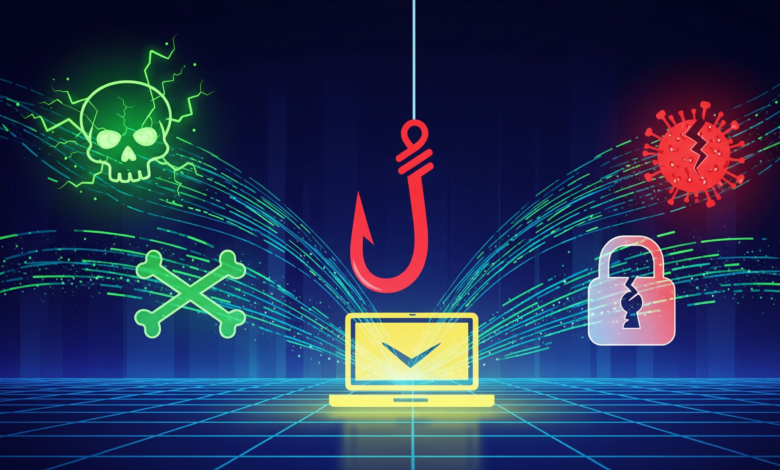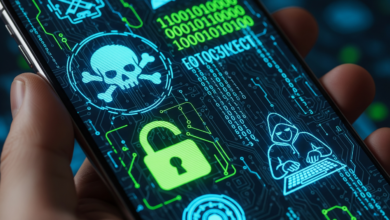Phishing Attacks Explained: How to Spot and Avoid Online Scams

Introduction to Phishing Attacks
Phishing attacks represent a significant threat in the digital landscape, involving deceptive strategies aimed at acquiring sensitive information from individuals under false pretenses. Primarily, these attacks are executed via fraudulent communications, often impersonating reputable organizations or individuals. Phishing is typically characterized by its intent to mislead victims into providing personal data, such as passwords, credit card details, or social security numbers, which can subsequently be exploited for various malicious purposes.
The formats through which phishing scams manifest are diverse, including emails, instant messages, and compromised websites. Email phishing is perhaps the most recognizable form, wherein attackers send messages that appear to be from legitimate sources. These emails often contain links that direct users to counterfeit websites designed to capture their information. Similarly, SMS phishing, or “smishing,” utilizes text messages to entice recipients into clicking on dubious links, while website phishing involves creating fake sites that closely mimic those of real companies. The varied forms of phishing attacks contribute to the complexity of identifying and preventing them, making awareness essential.
In today’s digital age, the prevalence of phishing attacks has escalated dramatically, affecting individuals and organizations alike. This surge can be attributed to the increasing reliance on online communication and transactions, which provide cybercriminals with ample opportunities to exploit unsuspecting victims. Awareness of the characteristics that define phishing scams is paramount in mitigating these risks. Recognizing common tactics employed by cybercriminals allows individuals to be more vigilant and cautious when interacting with unfamiliar communications. Understanding the underlying principles of phishing is crucial for fostering a safer online environment and encouraging responsible internet usage.
Common Types of Phishing Attacks
Phishing attacks have evolved dramatically over the years, resulting in a variety of sophisticated techniques designed to deceive individuals and organizations alike. Understanding these common types of phishing attacks is crucial in safeguarding against potential threats.
Spear Phishing is a targeted approach where attackers customize their messages to a particular individual or organization. Unlike generic phishing scams, spear phishing focuses on personal details, often drawn from social media profiles or previous correspondence. For example, an attacker may impersonate a company executive, sending a seemingly legitimate email requesting sensitive information from a trusted employee. The high degree of personalization makes it easier for the recipient to fall victim to such schemes, highlighting the importance of skepticism when handling requests for confidential data.
Whale Phishing, a subset of spear phishing, specifically targets high-profile individuals such as executives or senior management. The term “whale” denotes large targets in the ocean of potential phishing victims. Attackers may employ a similar strategy as spear phishing but with heightened stakes due to the potential access to sensitive company information or financial resources. An example includes a fraudulent request for a wire transfer under the guise of a company finance officer, further emphasizing the need for stringent verification processes within organizations.
Another prevalent form is Vishing, or voice phishing, which involves phone calls instead of emails. Attackers may call an individual, often appearing to be from a legitimate business, and request sensitive information such as social security numbers or bank details. An example of vishing is when a caller claims to be from a bank’s fraud investigation department, urging the victim to verify account details urgently. Such tactics exploit trust and anxiety, making critical awareness essential to avoid falling prey to these audacious methods.
In recognizing these phishing types, individuals and organizations can enhance their defenses and reduce the likelihood of being compromised by these insidious scams.
Red Flags: How to Spot Phishing Attempts
Phishing attacks are increasingly sophisticated, making it crucial for individuals to recognize the key warning signs that can indicate a phishing attempt. One of the first red flags to pay attention to is the email address of the sender. Phishing emails often originate from addresses that closely resemble legitimate ones but may contain slight alterations, such as a missing or additional letter, or a different domain. For example, an email from ‘support@yourbank.com’ could be spoofed as ‘support@yourbanik.com.’
Another common indication of a phishing attempt is poor grammar or spelling mistakes. Emails that come from legitimate sources typically adhere to professional standards of communication. If an email is peppered with typos or awkward phrasing, it may warrant further scrutiny. A legitimate organization will quality-check their communications, whereas phishers often produce hastily crafted messages.
Urgent calls to action frequently signal phishing scams. Many phishing emails attempt to create a sense of urgency to compel recipients into acting quickly, such as clicking a link or providing personal information. Phrases like “Your account will be suspended!” or “Immediate action required!” often appear in these scams, instilling panic that can lead to hasty decisions.
Unexpected attachments or links are also significant red flags. Be cautious of unsolicited emails containing attachments or hyperlinks, particularly if you were not expecting them. When hovering over a link, ensure that the destination URL matches the context of the email; phishing attempts often hide malicious links behind seemingly safe text.
Lastly, generic greetings and lack of personalization can point to phishing attempts. Emails from legitimate sources typically address you by name, whereas phishing emails may use vague phrases such as “Dear valued customer.” Recognizing these red flags can equip you with the tools needed to navigate online interactions safely.
Techniques Used by Cybercriminals
Phishing attacks represent a significant threat in the digital landscape, often characterized by the cunning strategies employed by cybercriminals. One of the most pervasive techniques is social engineering, which relies on manipulating human psychology to elicit emotions such as fear, urgency, or curiosity. Cybercriminals craft messages that appear to be from legitimate entities, encouraging individuals to click on links or divulge personal information. This often involves creating a sense of urgency, suggesting that immediate action is required to avoid dire consequences, thereby making unsuspecting users more susceptible to their schemes.
Another common tactic is the creation of fake websites that closely mimic official sites. These counterfeit websites usually have similar URLs and layouts, designed to trick users into inputting sensitive information such as passwords or credit card details. Once a user lands on these fraudulent pages, it becomes exceedingly difficult for them to differentiate between the real and the fake, especially under the pressure of established trust. To enhance the illusion of legitimacy, cybercriminals may employ secure HTTPS connections or convincing branding, further complicating the user’s ability to discern the reality behind the digital façade.
Moreover, leveraging public data for personalization has emerged as a notable strategy among cybercriminals. By scouring social media platforms and public records, they can gather extensive information about potential victims, enabling them to tailor their phishing attempts. This personalization makes the attack messages more convincing, as they may reference specific details about the victim’s life or interests. Such tactics not only increase the likelihood of a successful phishing attempt but can also leave individuals feeling violated and more vulnerable in the future. Understanding these techniques offers critical insights into the complexity of phishing attacks and emphasizes the necessity for vigilance in safeguarding personal information.
Protective Measures Against Phishing Attempts
Protecting oneself from phishing attacks requires a multi-faceted approach that encompasses various best practices and proactive strategies. By incorporating these measures into daily online activities, individuals and organizations can significantly reduce their vulnerability to such scams.
One of the fundamental steps is to use strong, complex passwords. Passwords should be at least twelve characters in length and consist of a mix of uppercase letters, lowercase letters, numbers, and special symbols. Additionally, it is advisable to avoid using easily guessable information such as birthdays or common words. To enhance security further, individuals should consider changing their passwords regularly and utilize unique passwords for different accounts.
Another essential protective measure is enabling two-factor authentication (2FA) wherever possible. This additional layer of security requires not only a password but also a secondary piece of information—such as a code sent to a mobile device or an authentication app—to access accounts. This significantly decreases the likelihood of unauthorized access, even if a password is compromised.
Staying informed about the latest software updates is crucial as well. Regularly updating operating systems, browsers, and applications helps patch known vulnerabilities that hackers often exploit. Many phishing attacks take advantage of outdated software to infiltrate systems, making it imperative to maintain current updates.
Lastly, employing reliable antivirus programs and firewalls can provide an effective defense against phishing schemes. Modern antivirus solutions offer real-time protection and can identify suspicious activities, including phishing attempts in emails and on websites, before they can cause harm. By utilizing these protective measures and fostering a culture of caution regarding online interactions, individuals and organizations can enhance their overall cybersecurity posture and minimize the risks associated with phishing attacks.
What to Do if You Fall Victim to a Phishing Attack
Experiencing a phishing attack can be distressing, but taking prompt and decisive action can significantly mitigate the damage. The first step is to identify if you have provided any personal information, such as passwords or credit card details, to the potential fraudster. If you suspect you have shared sensitive information, immediate steps must be taken to protect your accounts.
One of the first actions you should take is to contact your bank or financial institution. Inform them about the phishing incident; they may have specific protocols in place to safeguard your account from unauthorized transactions. If you’ve noticed any unusual activity in your accounts, it’s crucial to report it immediately so that they can take necessary measures to secure your funds.
Following this, changing your passwords is paramount. Update not only the password for your affected accounts but also for all other accounts that might share similar credentials. Use unique and complex passwords for each account, incorporating a mix of letters, numbers, and symbols. Enabling two-factor authentication where available can add an additional layer of security.
Next, it is advisable to report the phishing attack to relevant authorities. Depending on your country, you can report the incident to organizations like the Federal Trade Commission (FTC) in the U.S. or Action Fraud in the U.K. Reporting these scams helps build awareness and can assist others in avoiding similar situations.
Lastly, it is essential to monitor your accounts closely for any suspicious activity in the following weeks. Regularly check your bank statements, credit reports, and any accounts linked to your email for unauthorized usage. This vigilance can help catch potential fraud early, allowing for swifter interventions.
Taking these steps can significantly aid in recovering from a phishing incident and help in establishing a more secure online presence.
The Role of Organizations in Preventing Phishing
Phishing attacks have become increasingly sophisticated, targeting not only individuals but also organizations. As a result, it is essential for organizations to adopt a proactive approach to safeguarding their employees and customers from such online scams. One of the primary responsibilities organizations hold is the training of employees to recognize and respond to phishing attempts. Comprehensive training programs should cover the various forms phishing can take, including deceptive emails, fraudulent websites, and the social engineering tactics often employed by attackers.
In addition to training, organizations should implement robust security policies that include clear protocols for handling suspicious communications. These policies play a crucial role in establishing a structured framework that guides employees on how to report potential phishing incidents. Consistently reinforcing these policies helps build a heightened awareness of security practices among staff.
Using email filtering tools is another effective strategy for organizations seeking to mitigate phishing risks. These tools can help proactively detect and neutralize malicious emails, thereby reducing the likelihood of employees falling victim to scams. Investing in advanced cybersecurity software that constantly updates to recognize new threats can greatly enhance an organization’s defenses against phishing attacks.
Moreover, promoting a culture of cybersecurity awareness within the workplace is vital. Organizations should encourage discussions about cybersecurity, share updates about emerging threats, and highlight successful case studies on how phishing attempts were thwarted. Engaging employees in regular cybersecurity drills can also help reinforce their skills and readiness in identifying potential threats.
Overall, by prioritizing employee training, implementing stringent security policies, utilizing email filtering tools, and fostering a culture of awareness, organizations can significantly reduce the risk of phishing attacks. Vigilance and commitment to cybersecurity best practices are essential in combating these persistent threats.
Phishing Statistics and Trends
In recent years, the prevalence of phishing attacks has seen a dramatic rise, underscoring the growing threat posed to individuals and organizations alike. Data from various cybersecurity firms indicates that phishing attempts are now occurring at an unprecedented rate, with an estimated 3.4 billion phishing emails sent daily. This staggering figure reflects a significant increase, highlighting the ongoing evolution and sophistication of these scams.
Financial losses related to phishing attacks have also escalated. According to a report from the FBI’s Internet Crime Complaint Center, the total financial loss from reported phishing incidents exceeded $1.8 billion in just one year. This figure represents not only the direct monetary losses incurred but also highlights the associated costs, such as remediation and reputational damage. The gravity of these numbers emphasizes the importance of implementing rigorous antifraud measures within organizations to protect sensitive data and finances.
Demographic information reveals that phishing attacks affect a wide range of individuals and sectors. Research indicates that employees across industries, particularly in finance and healthcare, are prime targets. Furthermore, it has been observed that phishing scams are particularly effective against specific age groups, with those aged 25-34 being more susceptible to falling victim to these deceptive tactics. The psychological manipulation employed in these attacks, often exploiting urgency or fear, plays a crucial role in their increased success rates.
As phishing tactics continue to evolve, the need for awareness and education around identifying and avoiding these online scams has never been more critical. Understanding the current landscape of phishing attacks, alongside the associated statistics and trends, reinforces the need for ongoing vigilance in safeguarding both personal and organizational assets.
Conclusion: Staying Vigilant Online
In today’s digital landscape, the prevalence of phishing attacks underlines the necessity for heightened awareness and proactive measures by users. Throughout this blog post, we have explored various aspects of phishing, including the strategies employed by cybercriminals, the distinctive characteristics of phishing emails, and the effects these attacks can have on individuals and organizations alike. Understanding how to recognize these threats is the first step in safeguarding personal information and maintaining security.
To effectively mitigate the risk of becoming a victim of online scams, it is imperative that users remain vigilant during their online interactions. Regularly updating passwords, utilizing multi-factor authentication, and being skeptical of unsolicited communications are fundamental practices that can significantly enhance online security. Users should also be encouraged to familiarize themselves with common phishing tactics, such as the use of urgent language or unfamiliar sender addresses, which can serve as red flags during routine online activities.
Moreover, leveraging technology can bolster defenses against phishing attempts. Employing reputable email filtering solutions and security software can help shield against spam and malicious links, providing a vital layer of protection for sensitive information. By incorporating these strategies into daily habits, individuals can create a more secure online environment. It is important to disseminate knowledge about phishing scams within communities, thereby fostering a collective defense against online threats.
In conclusion, staying informed and cautious is crucial in combating the rise of phishing attacks. By adopting safe online practices and remaining vigilant, individuals can protect themselves and contribute to broader cybersecurity efforts. The continuous evolution of phishing tactics necessitates that users not only learn but also adapt to these changes, ensuring a robust defense against potential online threats.






















